by Jan Raska, PhD, Historian
(Updated November 5, 2020)
Introduction
Welcome to my first blog here at the Canadian Museum of Immigration at Pier 21! I’d like to share a bit of our collection with you today. After searching for interesting historical tidbits, I came across a few children’s ship and train menus from the 1940s and 1950s. These menus provide a unique window into how passenger travel evolved after the Second World War.
Today’s transportation companies increasingly cater to younger passengers by promoting their services and products to them and their parents. Youth now hold more spending power than they did in previous generations. In the immediate postwar period, the majority of travel between Europe and Canada was by ship. As air travel became more accessible with increased routes, less time spent in transit and lower fares, passengers turned away from ships and trains. For decades prior to this transformation, ships and trains were vital for travel. Many individuals passed through Pier 21: soldiers, war brides, home children, orphans, immigrants and refugees fleeing persecution.
Transportation Companies and Postwar Children’s Food Menus
In the years immediately after the Second World War, transportation companies such as: Cunard White Star Line, the Canadian National Railway (CNR) and the Canadian Pacific Railway (CPR) published children’s food menus aboard their ships and trains. In order to attract prospective travellers, transportation companies realized that illustrating the services they offered and the travel experience aboard was vital to acquire paying customers over their competitors.
Passengers making a transatlantic crossing in May 1945 aboard SS Duchess of Bedford (operated by Canadian Pacific Steamships Limited) received a ship menu with a front page containing a greeting from Captain H.S. Knight and crew wishing them “…all a successful future in Canada.” On 17 May 1945, the ship sailed from Liverpool, England. During the ten day journey across the Atlantic Ocean, “Children’s Tea” was offered and included: creamed minced chicken and ham, boiled fresh eggs, strawberry jelly with cream, vanilla ice cream, peach cream cake, biscuits, bread and butter, jam, fresh milk, tea or cocoa, and oranges.[1]
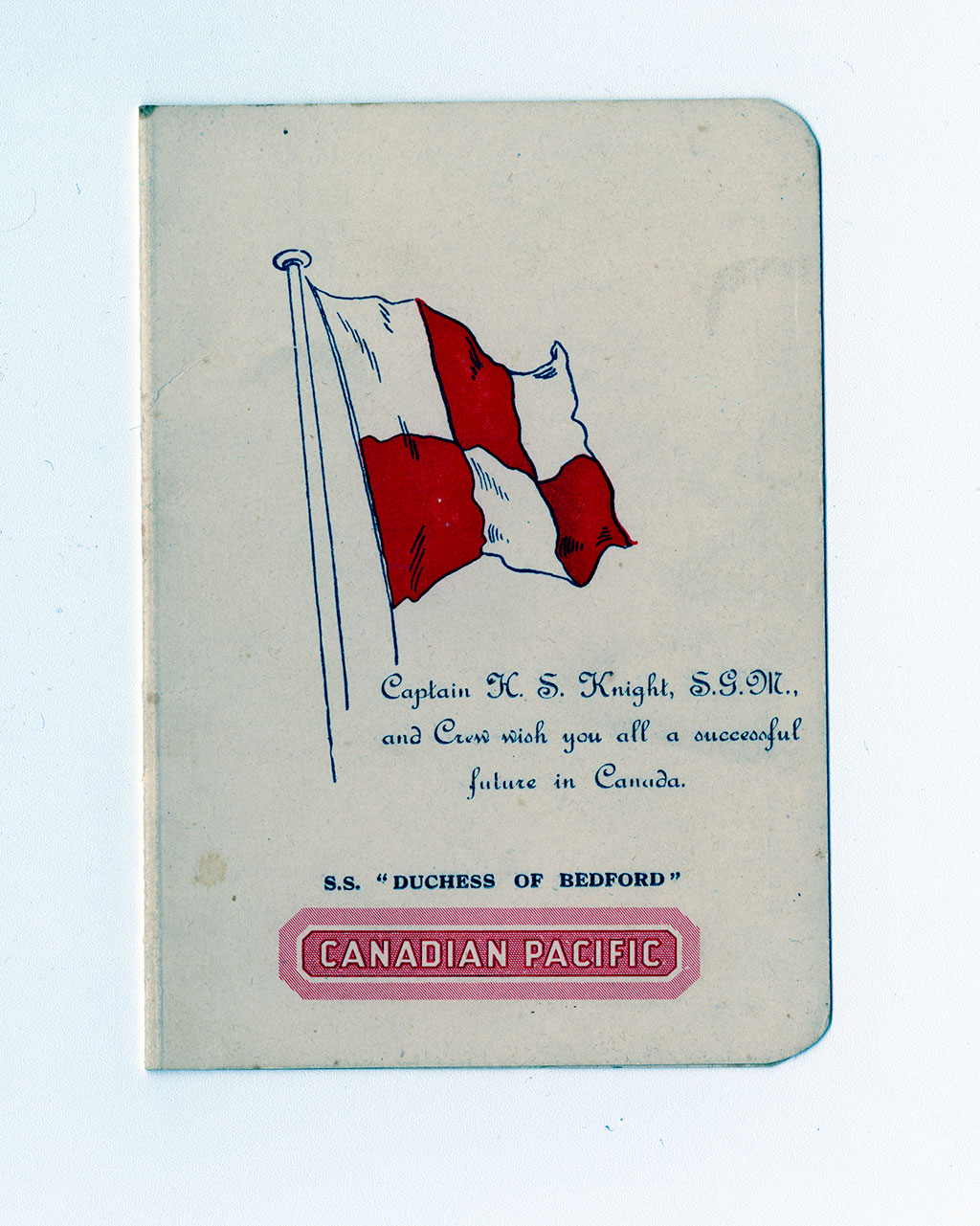
Credit: Canadian Museum of Immigration at Pier 21 Collection (DI2019.178.10)
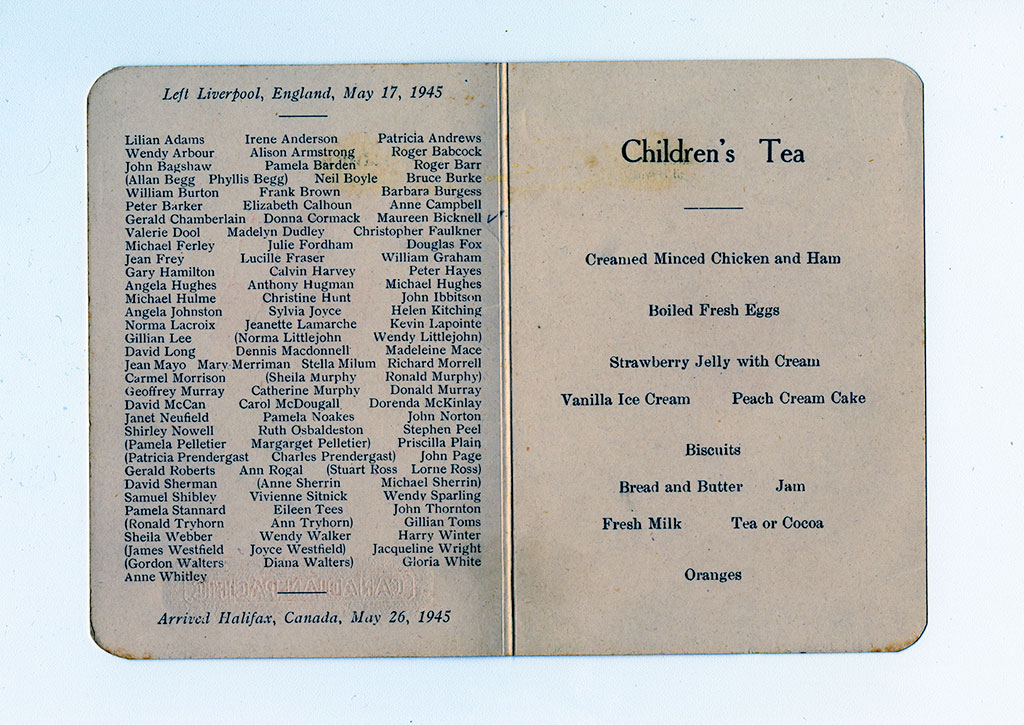
Credit: Canadian Museum of Immigration at Pier 21 Collection (R2014.34.5)
Certain foods on offer give us a window into the food choices, culinary preparation, and eating habits of travellers in the 1940s. The aforementioned food included a good source of vitamins, proteins and minerals, but also items heavy in fats and sugars. Today, how many children would eat creamed minced chicken and ham? Canadian Pacific Steamships Limited also offered baby food which could be “obtained on request to Steward or Stewardess…” The transportation company did also offer healthy choices for young passengers. Among the choices available were strained vegetables, fresh milk, Ovaltine, tomato juice, and Bovril to name a few.[2] On 26 May 1945, the passengers of SS Duchess of Bedford reached Canada’s shores and docked at Pier 21 in Halifax.
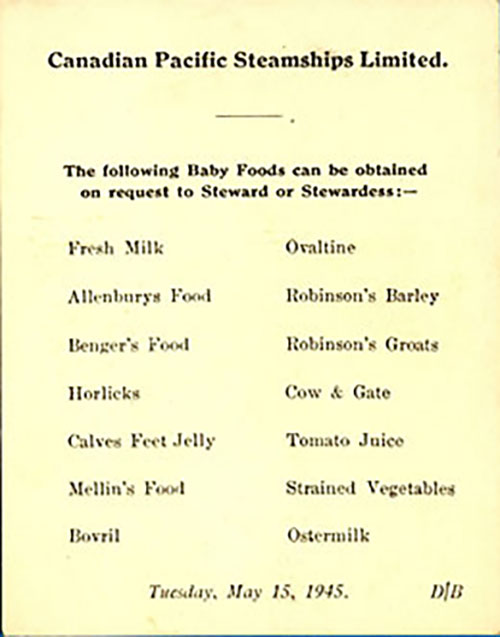
Credit: Canadian Museum of Immigration at Pier 21 Collection (R2014.34.5)
Aboard the Cunard White Star Line’s R.M.S. Mauritania in March 1946, young passengers could enjoy a “Children’s Tea Party” with the following invitation: “Hickory, Dickory Dock, We start at 3.30 o’clock.” The ship’s menu included: strawberry jam sandwiches, fruit cake, jellies, biscuits, ice cream, fresh milk, tea and oranges. Below the food choices was a little poem:
We sailed across the Ocean,
Although we’re very small,
We’re going to see our Daddies,
In our new found land
– Canada (5 March 1946)[3]
Transportation Companies Publish Pamphlets for Young Travellers
That same year, the CNR published a Dining Car Menu: For Little Folks. The front page contained illustrations of well-dressed children enjoying themselves while eating in the train’s dining car. The inner pages of the menu pamphlet contained illustrations and a story romanticizing the CNR and possible careers on the railways for children to look up to. A red cap (baggage handler), engineer, conductor, steward, waiter, and porter were all depicted. The menu pamphlet also informed adult passengers of the various services that were offered, from getting on the train, to baggage handling, and preparing sleeping accommodations in your sleeping car.
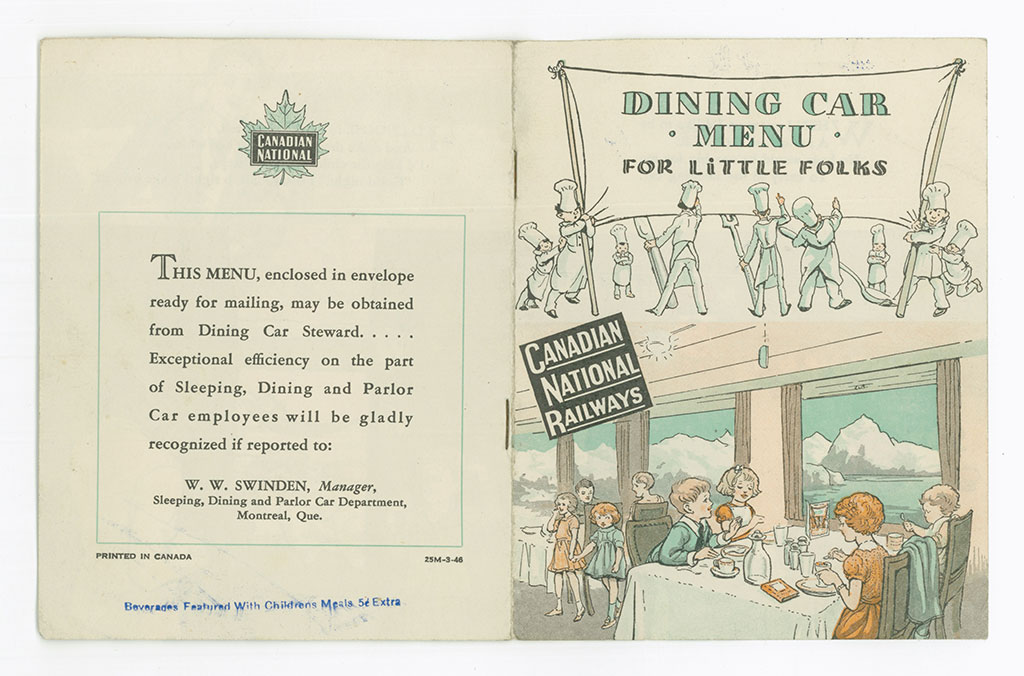
Credit: Canadian Museum of Immigration at Pier 21 Collection (DI2016.147.1)
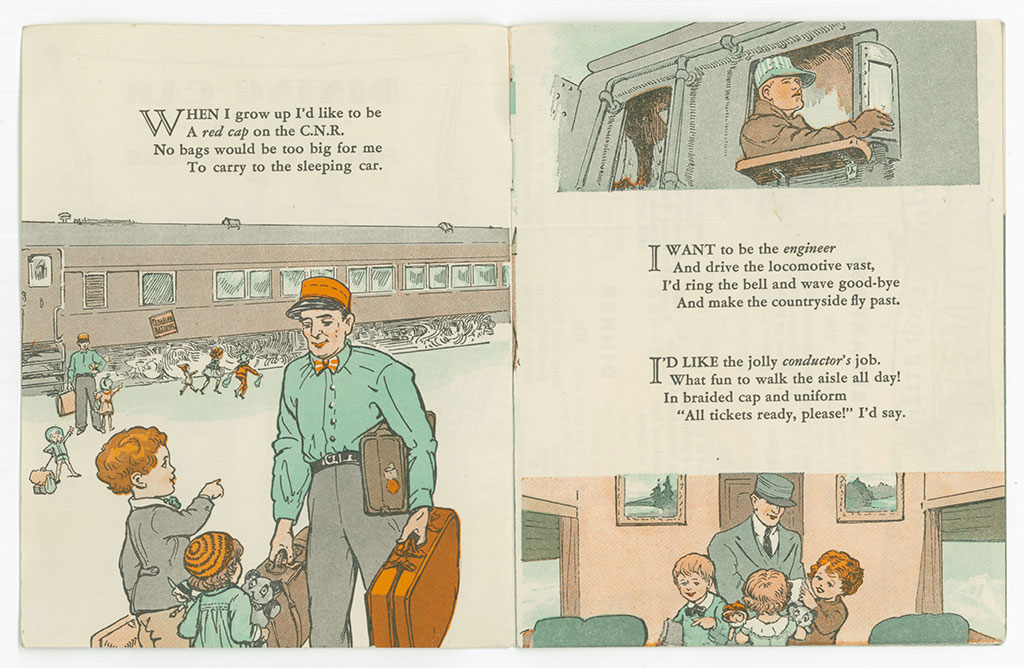
Credit: Canadian Museum of Immigration at Pier 21 Collection (DI2016.147.1)
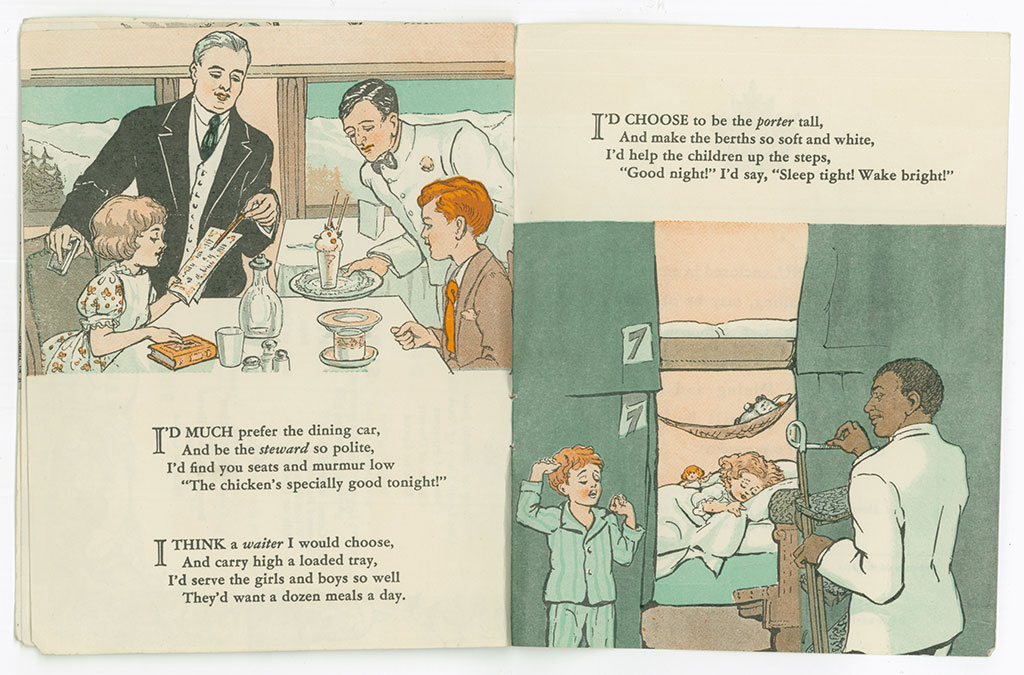
Credit: Canadian Museum of Immigration at Pier 21 Collection (DI2016.147.1)
The CNR asked its passengers to inform the manager of “exceptional efficiency on the part of Sleeping, Dining and Parlor Car employees [so they could]…be gladly recognized if reported…”. For little boys and little girls, the CNR offered breakfast, dinner and supper menus. The most expensive items came from the supper menu and cost $0.50 each. Items included scrambled eggs, buttered brown bread, cold sliced chicken, ice cream, milk and cocoa. The most affordable items were from the breakfast menu in which a choice of fruit, or a cereal bowl of bread and milk cost $0.25.[4]

Credit: Canadian Museum of Immigration at Pier 21 Collection (DI2016.147.1)
In 1946, the CNR’s Dining Car Menu for Little Folks included illustrations of a little bear climbing a tree, taking a snooze in the sleeping car, playing, and crossing the railway tracks. The back page of the menu contained an illustration of the bear serving supper to a little blond-haired girl. The dining table included two sets of forks, knives and a spoon. Prices for supper increased from $0.25 in 1946 to $0.85 in 1948 for the same items.[5]
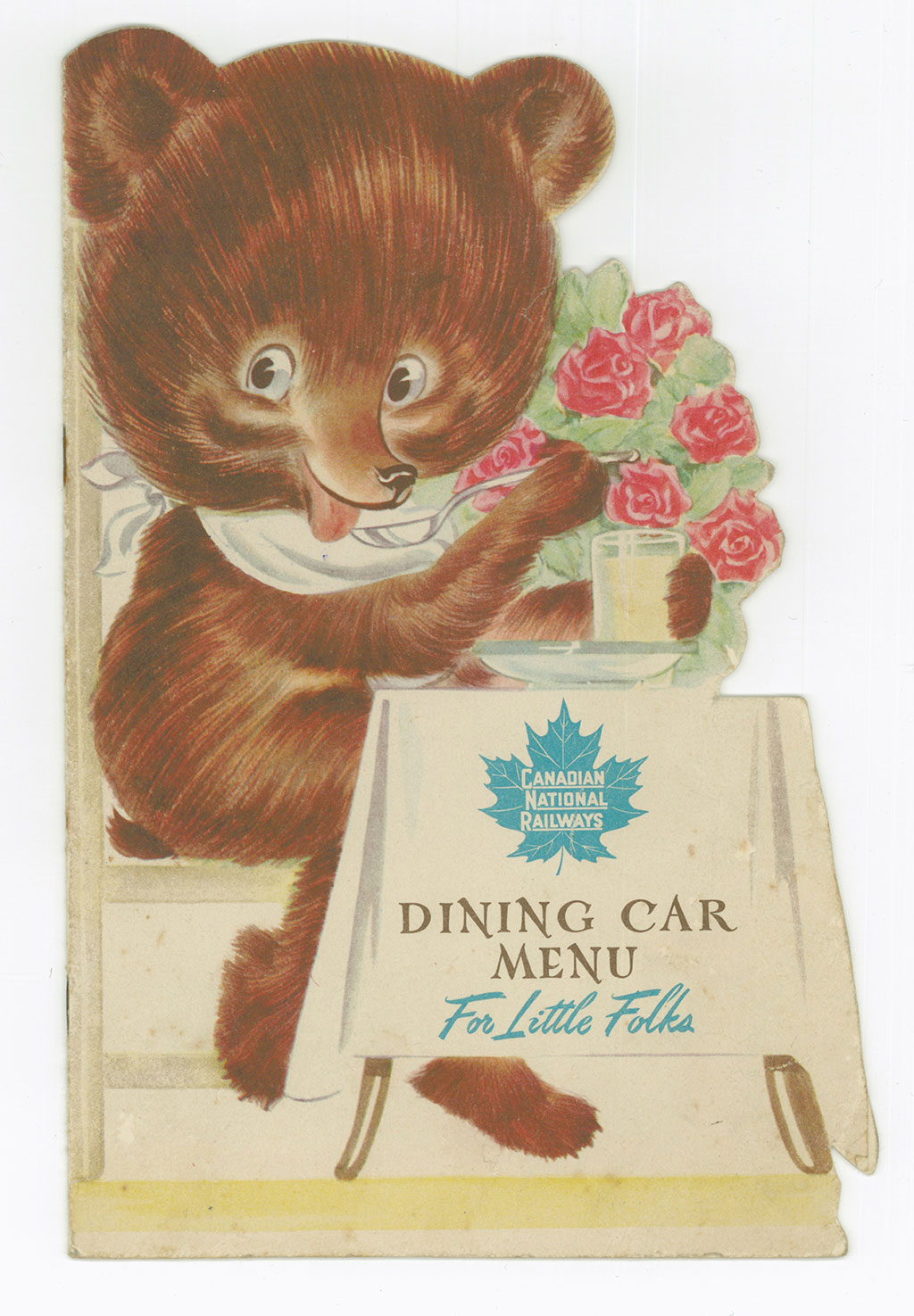
Credit: Canadian Museum of Immigration at Pier 21 Collection (DI2016.147.2)
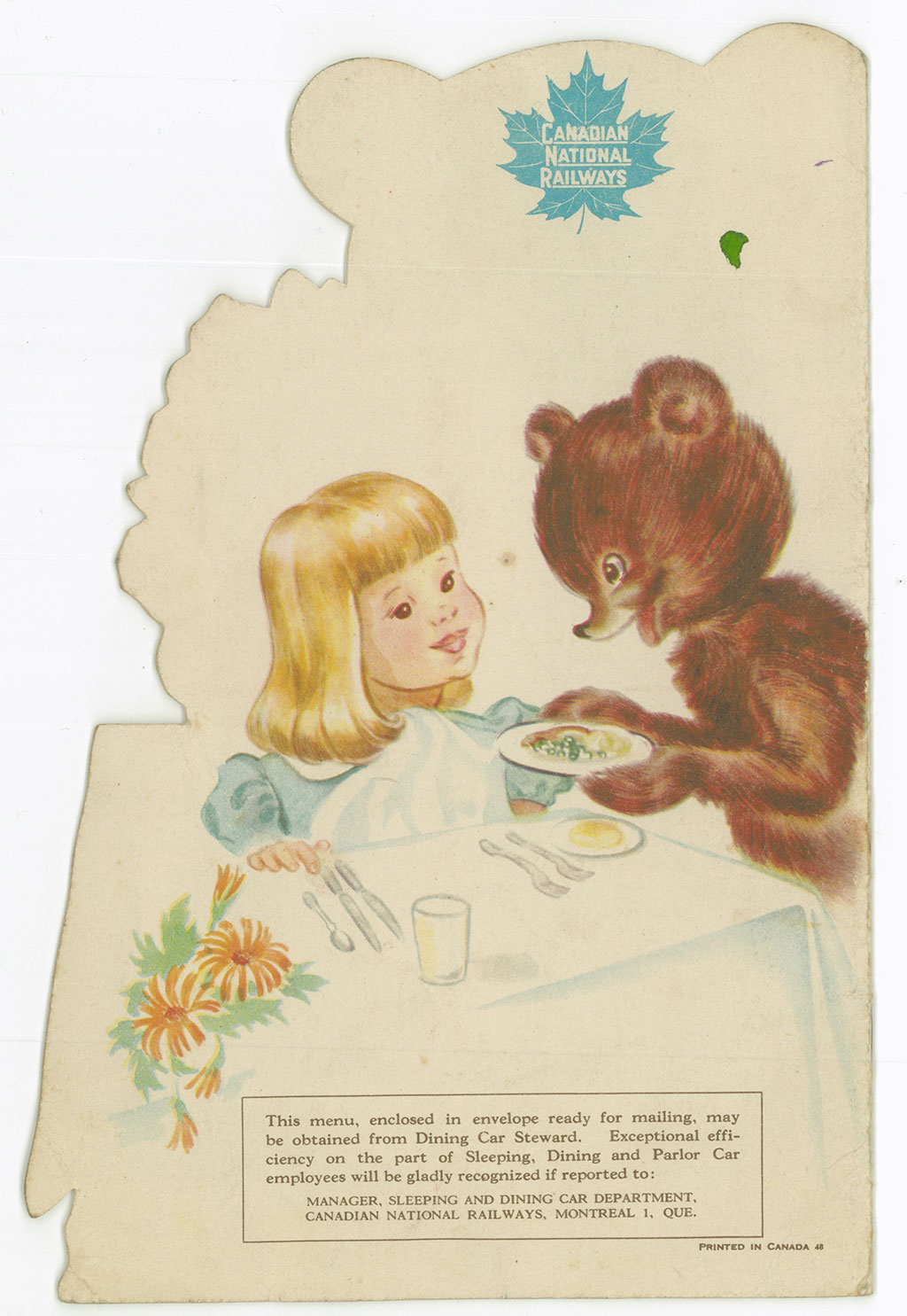
Credit: Canadian Museum of Immigration at Pier 21 Collection (DI2016.147.2)
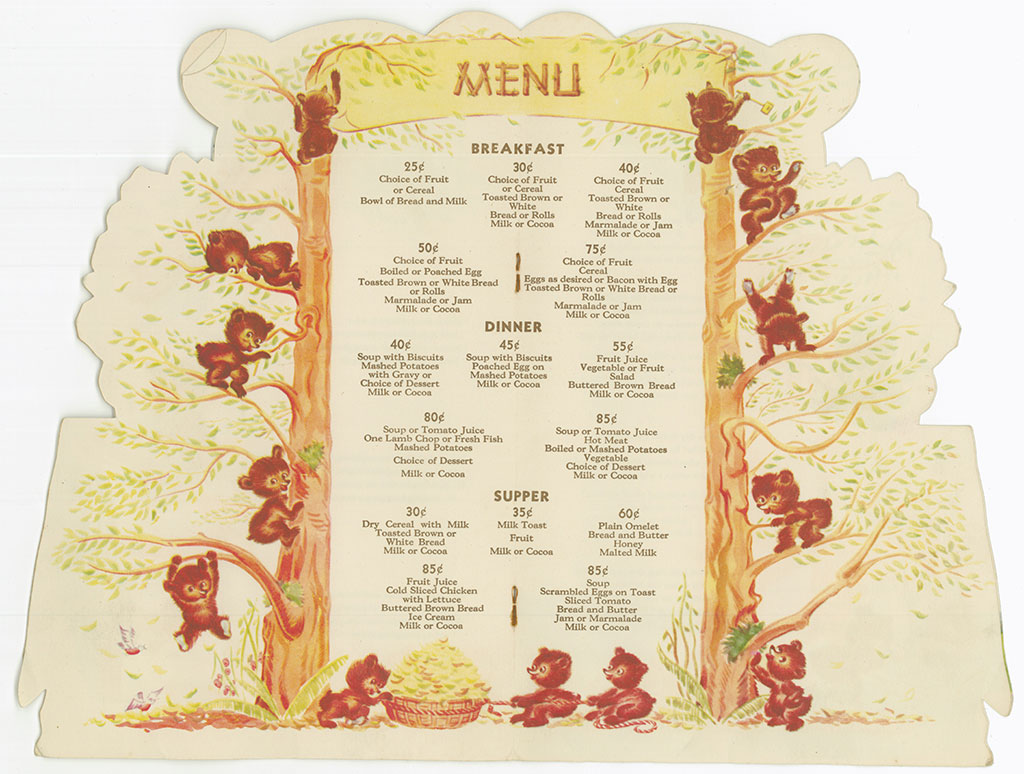
Credit: Canadian Museum of Immigration at Pier 21 Collection (DI2016.147.2)
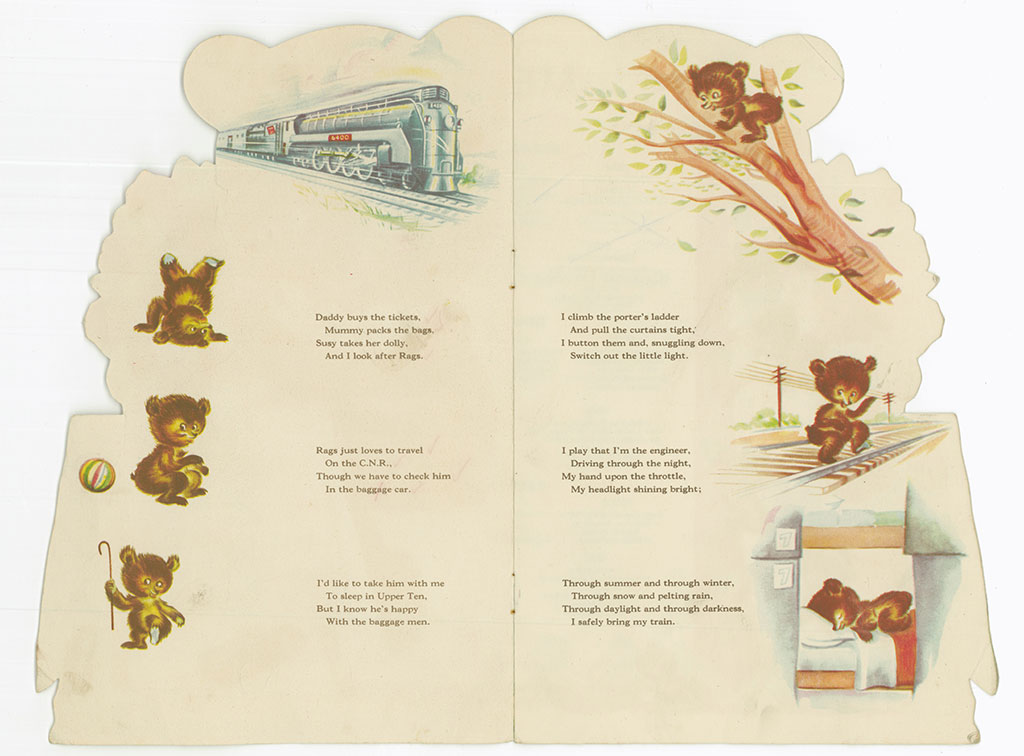
Credit: Canadian Museum of Immigration at Pier 21 Collection (DI2016.147.2)
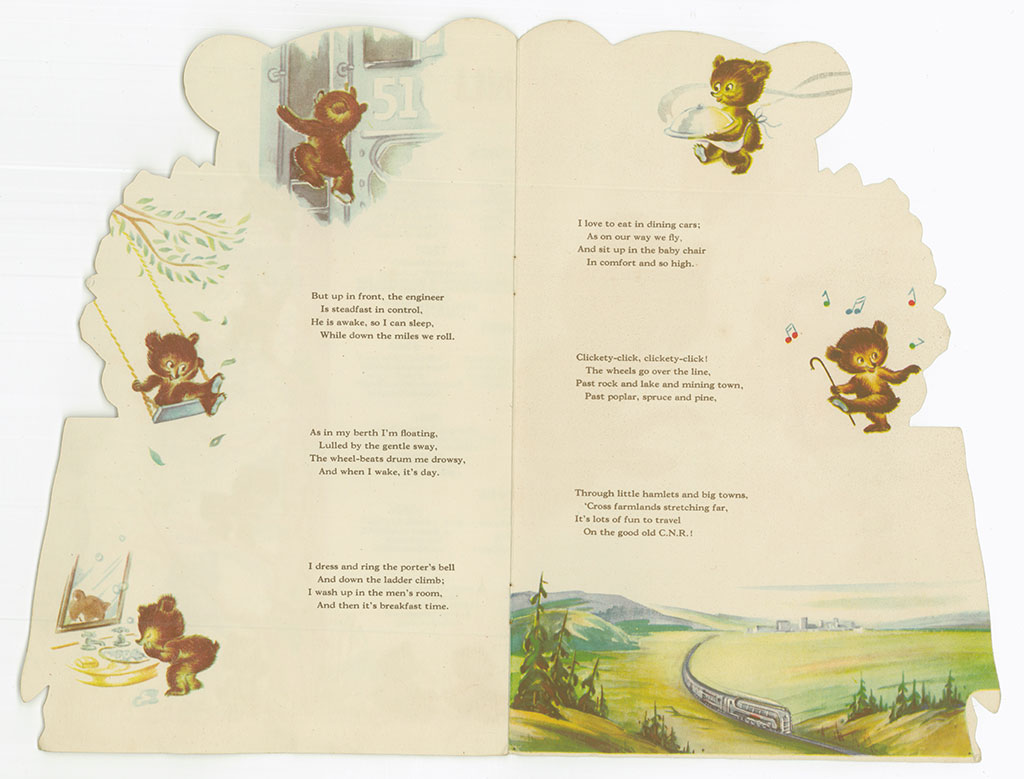
Credit: Canadian Museum of Immigration at Pier 21 Collection (DI2016.147.2)
In April 1953, the Cunard Line’s RMS Ascania offered a menu titled: “Children’s Party” and paired some of its offerings with fictional characters that children would recognize. Peaches and Cream was associated with Little Red Riding Hood, while Jack and Jill “went up the hill, Came back with Fancy Pastries.” Fruit tarts belonged to the Queen of Hearts and the Party Cake to Prince Charming.[6]
Sailing aboard the Netherland Line’s MS Johan van Oldenbarnevelt in May 1957, young passengers were offered tomato soup, marmalades, jams, cheese, tea and milk. For lunch, minestrone soup, baked cod, baked potatoes, and a mixed salad could be purchased. Aboard the ship, seasoned sausage, potatoes, Gouda cheese, peanut butter, apple syrup, tea, milk, chocolate and popcorn could be purchased for dinner. Quite a rich selection indeed![7]
Conclusion
Ship and train menus give us a glimpse into the history of passenger travel, transportation marketing and foodways among others. Over the past several decades, modes of transportation have drastically changed. In the 1940s, ship travel was the most affordable and efficient way of coming to Canada from Europe. Upon arriving in Canada at Pier 21, immigrants, refugees, soldiers, war brides, home children, and orphans, businesspeople and tourists boarded trains to continue their journeys to destinations across Canada.
- Canadian Pacific Ship children’s menu, May 1945, Canadian Museum of Immigration at Pier 21 (hereafter CMI) Collection (DI2019.178.10).
- Children’s Tea Menu from SS Duchess of Bedford, May 1945, CMI Collection (R2014.34.5).
- Menu from RMS Mauritania, March 1946, CMI Collection (DI2016.554.1).
- Menu for children from CNR, September 1946, CMI Collection (DI2016.147.1).
- Menu for children from Canadian National Railways, September 1946, CMI Collection (DI2016.147.2).
- Menu for a Children’s Party held on board RMS Ascania, April 29, 1953, CMI Collection (DI2014.278.50).
- Menu from MS Johan van Oldenbarnevelt, May 27, 1957, CMI Collection (R2014.89.1); Menu from MS Johan van Oldenbarnevelt, May 27, 1957, CMI Collection (R2014.89.2); Menu from MS Johan van Oldenbarnevelt, May 27, 1957, CMI Collection (R2014.89.3).
